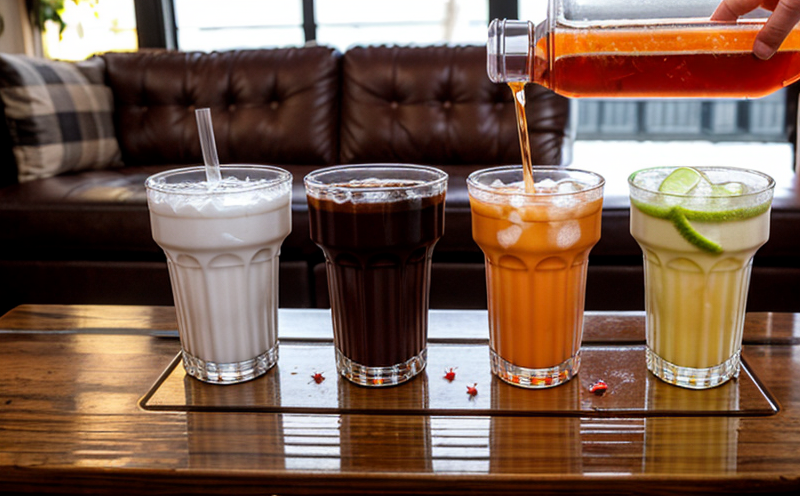AOAC 942.15 Alcohol Content Testing in Spirits
The AOAC International method 942.15 is a widely recognized standard for determining the alcohol content of spirits, including liqueurs, wines, and other alcoholic beverages. This procedure involves the use of gas chromatography (GC) to quantify ethanol present within the sample. The process begins with an accurate dilution of the beverage to ensure that the concentration falls within the linear range of the GC system.
The test is particularly important for quality control in the food and beverage sector, ensuring consistent product strength, compliance with labeling regulations, and protection against adulteration or misrepresentation of alcohol content. For R&D engineers, this method provides a reliable baseline to compare different formulations under development. Compliance officers rely on it to ensure that products meet national and international standards such as those set forth by the International Organization for Standardization (ISO) and the United States Department of Agriculture (USDA).
Preparation of the sample is critical; proper dilution ensures accurate GC analysis without overloading the column. The process typically involves volumetric transfer, ensuring that the correct amount of beverage is taken from the container into a measuring cylinder or volumetric flask. Once diluted to an appropriate concentration, the sample can be injected directly into the GC instrument.
The equipment used for this method includes a gas chromatograph with a flame ionization detector (FID), a nitrogen purge system, and a programmable temperature controller. The sample is heated through vaporization before being introduced into the column where separation occurs based on molecular weight and boiling point differences between ethanol and other components in the beverage.
The resulting peak area from the GC analysis corresponds directly to the concentration of ethanol present in the sample. This value, combined with knowledge of the dilution factor applied during preparation, allows for accurate calculation of the original alcohol by volume (ABV) content.
For a more comprehensive understanding, let us examine some key points:
- Dilution: Proper dilution is crucial to keep the ethanol concentration within the linear range of the GC instrument.
- Safety Precautions: Handling spirits requires careful attention due to their flammability and toxicity.
- Standard Operating Procedures (SOPs): Strict adherence to laboratory protocols ensures consistent results.
In summary, AOAC 942.15 is a robust method for quantifying ethanol content in spirits. Its precision makes it indispensable not only for regulatory compliance but also for maintaining product integrity and consumer trust.
| Sample Preparation | Instrumentation |
|---|---|
| Volumetric transfer, ensuring correct amount of beverage is taken from the container into a measuring cylinder or volumetric flask. | Gas chromatograph with flame ionization detector (FID), nitrogen purge system, programmable temperature controller. |
Eurolab Advantages
Eurolab, your partner in beverage testing excellence, leverages its extensive experience and cutting-edge technology to provide unparalleled precision and reliability when performing AOAC 942.15 alcohol content tests.
- Accurate Dilution: Our skilled technicians ensure precise sample preparation through accurate dilution techniques.
- State-of-the-Art Equipment: We utilize the latest gas chromatographs with flame ionization detectors, guaranteeing high-quality data collection.
- Comprehensive Reporting: In addition to quantitative results, we offer detailed reports that include methodological insights and recommendations for improvement if necessary.
Eurolab is dedicated to helping our clients achieve their quality goals. Whether you need routine testing or one-off assessments, our team stands ready to assist with all your beverage analytical needs.
Environmental and Sustainability Contributions
The practice of AOAC 942.15 alcohol content testing in spirits has significant environmental benefits, particularly when integrated into sustainable production practices within the food and beverage sector.
- Precision: By ensuring accurate measurement of ethanol levels, this method helps minimize waste by preventing overproduction or underestimation of ingredients.
- Regulatory Compliance: Adhering to standards like AOAC ensures that producers are meeting environmental regulations set forth by governing bodies.
At Eurolab, we strive for continuous improvement in our testing methodologies to further enhance sustainability. Our commitment extends beyond individual projects to broader industry initiatives aimed at reducing carbon footprints and promoting resource efficiency.
Use Cases and Application Examples
The AOAC 942.15 alcohol content test finds application across various scenarios within the food and beverage industry:
- Daily Quality Control: Monitoring daily production runs to ensure consistent ABV.
- New Product Development: Determining optimal ethanol concentrations for new products.
Let’s explore some practical examples:
| Scenario | Description |
|---|---|
| Daily Quality Control | Ensuring each batch of spirits meets specified ABV levels before bottling. |
| New Product Development | Testing different alcohol concentrations to find the best flavor profile while maintaining legal limits. |
These examples highlight how precise measurement plays a pivotal role in both day-to-day operations and innovative product creation.





